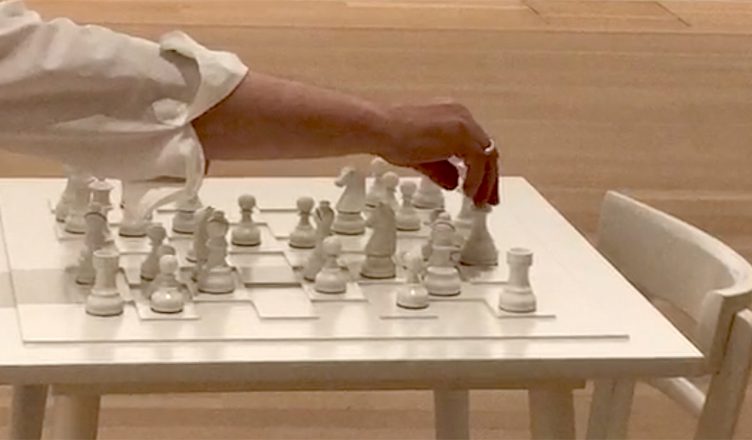White Chess Set I Version by Robert Krokowski
1. August 2025, 13:20, Gropius Bau Berlin/Germany
When Yoko Ono installed the White Chess Set in 1966, she added the following invitation: Chess set for playing as long as you can remember where all your pieces are.
When I followed this invitation on August 1, 2025, at the Gropius Bau in Berlin—almost 50 years after it was first extended—I was not only facing a white chessboard with white pieces on a white table, but also an empty white chair. I did not immediately start to play with the white pieces and the empty space opposite. I looked around the room, at one of the grey square images on the wall to my left, on which a single word was printed in the center: TOUCH. I looked invitingly at individual visitors. After a while, I touched a pawn and moved it. I realized that I was now deliberately playing with the empty chair opposite. It became a space of play that gave new play to my play. I noticed that I was making moves in response on behalf of the empty space—but also for possible other players. I thought of people who might be sitting there. Of games I had played. I captured pieces. I remembered the rule “touch-move.” I thought of dancing. Of the photograph of Eve Babitz’s game with Marcel Duchamp, taken through the Large Glass. I looked around and glanced over my shoulder at the glass installation with the hole, to which Yoko Ono’s invitation read: GO TO THE OTHER SIDE OF THE GLASS AND SEE THROUGH THE HOLE. And when I ended the game with a checkmate, I thought of the helmets hanging behind me from the ceiling, filled with puzzle pieces of the sky. I stood up, pushed the chair back to the table, and left the final position on the board. I recalled my land art installations: after assembling found objects, to leave the final configuration standing and lying there, and to walk away. I looked at the set for a moment from the side of the empty chair. I was amused by the now empty chair opposite me. A fine example, I thought, of the possibilities and impossibilities of the singular.
In performative action, neither events nor outcomes are fixed in advance. They are processual and depend on those involved. No finished work emerges that exists as complete; rather, what emerges is a fractal. Fractals are versions of the game that develop the configuration of the chess game installation into singular multiples or fractal variables. Their own time may be dated, but it is not chronologically measurable. For the updated White Chess Set is an example of an opportunity for performative action seized by the forelock: players make use of the moment in which the being of things condenses into kairotic time into a configuration of thus-being. This requires at least one player who prefers not to wait any longer.
In this way, concept and current performance merge in a work taking place, in a mobile workshop, into a new version of the game—into a by-play of joint action. For this reason, fractals are also exemplary singularities—and as such, variables for spaces of play in new forms of community. They refer the artistic variations of chess-playing to a new space of play: that of the possibility of changing, reconfiguring, and updating the game.
That is why a current fractal of Yoko Ono’s White Chess Set by actors who “play” it almost fifty years later is not a variation of chess-playing in the manner of Eve Babitz and Marcel Duchamp (Pasadena Art Museum, 1963)— or in the manner of the Reunion of Marcel Duchamp and John Cage (Toronto, 1968) . Those games are singular works which, though they can be varied through repetition and imitation, themselves issue no invitation to allow new performative versions to take place.
Yoko Ono’s White Chess Set, however, offers such a space of play. She herself makes use of it—for example, together with Anthony Cox (Yoko Ono and Anthony Cox playing chess on Ono’s White Chess Set (1966), with other works included in her exhibition in the background, Indica Gallery, London, November 1966). Names too change when they are used to describe the occurrence of work-fractals (as in the singular multiples in the manner of Yoko Ono). They themselves gain “play” and find the space which, according to Giorgio Agamben, bears the proper name Agio: “… the free space that everyone needs in order to be able to move freely, in which spatial proximity borders on the opportune moment (ad-agio, aver agio, to have the occasion) (…)” (Giorgio Agamben, The Coming Community, Berlin 2003, p. 28).
Some understand the word “placeholder” militarily, seeing actors as lieutenants in a proxy chess war—but the players in Yoko Ono’s set are not quantities to be reckoned with, but agents to be counted on; they do not represent traits or properties of warmongers, but the possibility of coexistence among instigators of peace. That is why Yoko Ono’s invitations have more in common with an invitation to dance together than with a challenge to battle: anyone is invited, including all the unloved who never tire of justifying proxy wars. They too are invited—to let themselves be tickled until, in laughing at themselves, they throw off the mask of ideology, to reveal the emptiness in whose place a human face could also appear.
Yoko Ono: “At the beginning everything is fine if you win; but if you lose, they start saying: ‘Oh, isn’t that mine?’ … ‘No, no. That’s mine,’ you know, and somehow try to trick each other. And you can play with that. It’s a very interesting game because it tickles you a little bit, you know? The result is fun and laughter. Not serious at all—and so is life, you know?” (MoMA audio link)
This does not change even if, in one version of the White Chess Set, one of the two chairs remains empty. That chair then invites one to sit down and let a shared game take place, in which with and against are suspended. This is the current question: can warmongering be rendered ineffective by giving the conscripted the possibility to experience in play how not playing is possible?
If artworks are no longer solely material artifacts, but configurations for collective action, then another invitation by Yoko Ono—issued together with John Lennon in 1969—proves its currency: Give peace a chance.
Robert Krokowski
-> Bag Piece I Hommage à Yoko Ono I Version by Marlen Wagner

